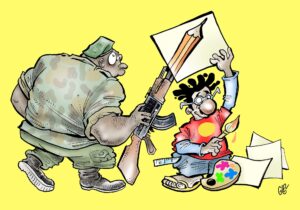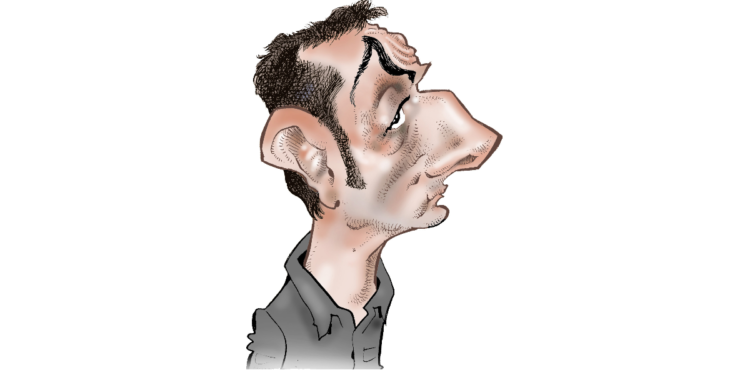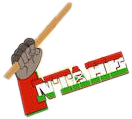Throughout history, political cartoonists have been censored, jailed, and even killed because of their work. But this has not stopped editorial cartoonists from continuing to use their art to draw society together by raising awareness on social, political, and economic issues.
In Burkina Faso, Damien Glez has become a voice for the voiceless, using his cartoons to address issues of governance and corruption. He also uses his cartoons to call out human rights violations and to advocate freedom of expression, press freedom, and democracy in Burkina Faso and beyond.
His renowned cartoons are published across the globe, including in the Vita non-profit magazine (Italy), Slate Afrique (France), World Policy Journal (USA), The Africa Report (Africa), Jeune Afrique (France-Africa), Le Monde, Libération, and France 24. He is also the author of the comic book Divine Comedy and also the weekly satirical newspaper Le Journal du Jeudi (Burkina Faso).
Glez talked to Journalists For Justice (JFJ) about how he uses his work to highlight serious issues that are often ignored.
When did you start drawing cartoons?
I have drawn since the beginning of my childhood. When I was around 10 years old, I discovered caricatural illustrations, which fascinated me. As a teenager starting to take an interest in international news, I drew my first cartoons. I didn’t think I would become a professional cartoonist, so I did other types of studies. Finally, I published my first professional cartoon, in Burkina Faso, at the age of 24.
What do you feel is the most important role of a cartoonist in society?
To awaken minds and consciences. He doesn’t really offer solutions; he is neither an authority nor a teacher, and doesn’t promote his personal opinion so much. Thanks to the style of the cartoon – humour, graphics, provocation – he draws the attention of the reader to subjects that deserve debate. Sometimes, in a context other than the press, the cartoonist can become an activist for important causes such as peace, women’s rights, freedom of expression, and democracy.
What drew you to cartooning for social change, and what motivates you to continue creating cartoons that tackle critical social issues such as justice and human rights?
Drawing is a form of expression that arouses attention and reaction, particularly in Sahel countries where the populations are often mostly illiterate. The press cartoon seemed to me an excellent tool for defending causes that are close to my heart.
How do you choose the topics or cases you feature in your cartoons?
They depend on the potential partners with whom I work. In the field of the press, I generally choose news that is essential. When working with organisations dedicated to specific social activities, we discuss the topics to be addressed. This has mainly been the inspiration for my work in cartooning for various causes.
What is the most important message you hope to communicate through your work?
Tolerance. It is from tolerance that debates can open up, that everyone can be heard, that peace can be found, that minorities can be respected, and that collective solutions can be found. Tolerance can be a source of inspiration, understanding, and dialogue. Every individual must understand that we are different and that we can build something better together through dialogue, respect, and cooperation. I try to reflect this message at all times.
I also hope to inspire other cartoonists in Burkina Faso and elsewhere to use their art to draw attention to social and political issues so that more voices can be heard in the fight for justice, freedom of expression, press freedom, and democracy.
These are important messages that we should keep in mind as citizens of the world. We must all stand up for what is right and strive for a better future for everyone.
In some of your work, you blend humour with more serious messages – how do you strike that balance?
This is where the interest and difficulty of the profession of a press cartoonist lie: balancing humour and serious messages. Depending on the seriousness of what is mentioned, it is sometimes necessary to favour emotion and compassion and sometimes to use provocation to make decision-makers and opinion-setters react.
What are some of the biggest challenges you face when producing cartoons for justice and human rights?
We must think carefully about the consequences of a cartoon. Is the idea clear and unambiguous? Does it risk being misinterpreted? If the cartoon is too direct, doesn’t it risk harming the victims of human rights abuses by annoying their perpetrators? This is by far the most significant challenge I face when producing cartoons for justice and human rights: how to be precise, yet not abusive.
How do you respond to criticism, and how do you deal with threats or intimidation?
Reacting to criticism should be avoided as much as possible unless it is legitimate, for example, if the cartoon has been sincerely misinterpreted. As for threats or intimidation, they must be answered calmly when a reaction is unavoidable, such as during a summons by the police.
What is your most memorable or significant cartoon, and why?
The most crucial cartoon in my career is one I drew to represent both my job and one of the essential issues in Burkina Faso: the involvement of the military in political life, with around 10 putsches since independence (two in 2022).

Photo Image Credit: Glez
The cartoon was also used as the poster for a festival we organised in 2011 in Ouagadougou, a few weeks after clashes between soldiers and police. Tignous, one of the victims of the Charlie Hebdo attack, was present.
This is an example of a cartoon that left the framework of the press to find itself in the street.
What are some of the most memorable reactions or responses that you’ve gotten to your cartoons?
In the country where I work, Burkina Faso, I suffered some pressure from the political authorities, but nothing severe. From a distance, some politicians have complained (Zimbabwe, Morocco, and Tunisia, to name a few). The most memorable threats have come from West African clerics and their cronies.
There are also positive reactions. The most striking is when cartoons are redistributed by associations or printed in school textbooks.
What advice would you give aspiring cartoonists who want to use their art to effect social change?
I would tell them they have to work hard, not lose courage, question themselves, and, above all, show constant honesty. The press cartoonist must understand that he has a responsibility as a journalist.
What do you feel is the best way to use cartoons to promote social justice and human rights?
To use cartoons effectively to promote social justice and human rights, it is necessary to multiply the media, particularly through digital networks. When possible, it is also necessary to get closer to young people and use cartoons as educational tools. Intervening in schools is equally important.







